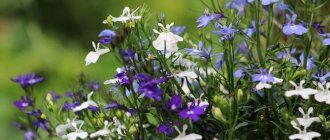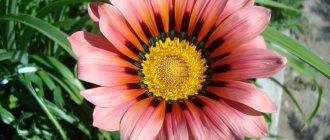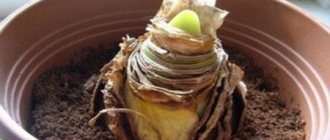Lightness, grace, decorativeness are the qualities for which flower growers fell in love with Chinese carnations. In its natural environment it grows in the harsh latitudes of East Asia. Despite this, the perennial Chinese carnation does not tolerate cold weather. Her ancestors identified her with the “divine flower.” This is how it is literally translated from Latin. They believed that its appearance was associated with the goddess of hunting Artemis, who, in a fit of anger, punished a simple shepherd for his singing, and the red color of the carnation was a drop of his blood.
Descriptions and types of plants with photos
As an ornamental plant, the flower has been grown for several centuries. During this time, many hybrid varieties were developed. Carnations are characterized by double inflorescences of various shades, located on tall stems, the height of which ranges from 15 to 35 centimeters. Particularly popular are small compact bushes framed by lush flowers. Based on appearance, it is divided into simple, double and semi-double types.
Diana F1 Crimson
This species was bred by Dutch breeders. Diana is equally suitable as a house plant or for decorating borders. This species will decorate any flower bed due to its bright and large flowers, the diameter of which is 5-7 centimeters. The height of the stem is 20-25 centimeters.
Peculiarities:
- Diana blooms from July to cold weather;
- Does not like waterlogged or dry soil. In hot weather, its flowers should be sprayed twice a day;
- It requires good aeration, especially in rainy weather.
Feed twice a month during the flowering period, alternating organic and mineral fertilizers. Depending on the subspecies, the flowers can be white, purple, bright pink, crimson, or fiery red.
Grace F1 Crimson
Another representative of the Dutch carnation selection is Grace F1 Crimson with bright red double flowers and white stamens. The diameter of the flowers ranges from 6 to 8 centimeters, the height of the stem is 25 cm.
Characteristics:
- Early flowering. Seeds are planted in April. The first shoots appear after 10 days;
- In open ground, the bushes remain compact without losing their decorative appearance.
You can grow them at home, in pots. Grace blooms from June to September.
Terry mix
The peculiarity of the terry appearance is in the petals with jagged edges and slits. The plant blooms from early to late summer. The flowers are small, with a diameter of one to four centimeters. One or more flowers can be located on one stem, forming a kind of bouquet. Mixed terry cloves have virtually no odor. Ideal for growing at home.
Vorozheya
The striking coloring of Vorozhey’s species immediately attracted the attention of flower growers. The stems have many branches strewn with dark crimson flowers with a white, thin edge. The diameter of the flower is 3-4 centimeters. The maximum height of the stem is 40 centimeters.
Characteristics:
- Vorozheya is planted from March to April;
- Abundant flowering from July to September;
- Easy to care for.
Carousel (Merry Go-Round)
Chinese double carnation Carousel is a dwarf species. Its stems are gnarled, strewn with many white flowers with a red center. Their diameter is 5-6 centimeters. An interesting combination gives a sophisticated appearance.
Characteristics:
- Not afraid of cold weather;
- Shoots appear after 6 days;
- Blooms from summer to late autumn.
Decorative moment
When including carnations in a flower arrangement, remember that a tulip will become a harmful neighbor for it. Flowers have similar diseases and parasites, but they must be treated differently. Treatment preparations can harm both neighbors.
Most often, Chinese double carnations are used in the design of monoflower beds, because the color range of the plant is quite rich, and the stems are able to cover the entire allocated space. Combination with other colors may also be appropriate. It is better if the carnation’s neighbors are tall enough: more than 40 cm, so that they stand out against its background and do not drown in it. Irises and roses are suitable in this regard.
Compliance with planting standards (distance between plants), timely weeding and pruning will help prevent Chinese carnation from turning into a weed..
Chinese carnation is an ornamental plant. Although there is a spice with the same name, the seeds of the flower should not be used in this role. Spicy cloves come from the clove tree, not the flower bed. Dishes with the wrong ingredient will cause health problems.
Decorative carnation is a good gift. Although different countries treat certain flowers differently. Giving an Englishman a white carnation will hurt his sense of dignity, because in this country the flower is considered the lot of the working class. Previously, miners planted it near their houses to take their eyes off the bright prospect after dark working days.
Presented as a gift to a Russian, even a man, a red carnation will become a symbol of the spirit of victory, expectation of manifestations of courage or gratitude for courage already shown.
A carnation bud pinned to the lapel of a jacket is considered in European countries a symbol of aristocratic origin and an easy attitude to life.
The flower was also often used by seamstresses to decorate dresses. The unfading beauty of carnations helped highlight the dignity of any woman.
Chinese carnation planting and care
Regardless of the type of Chinese carnation, you need to choose the right place before planting. The herbaceous plant should be planted on the sunny side of the site or in a slightly darkened side. In the absence of plenty of sun, garden carnations stretch out and practically do not bloom.
Tip: When choosing a suitable place, you need to remember that Dianthus chinensis loves moisture, but does not take root when water stagnates in the soil. Therefore, it is necessary to consider good drainage. Liming the soil will help get rid of excess water.
The choice of soil is influenced by climatic conditions. In the Northern regions, cloves grow well in loose and sandy soil. The main condition is that the site should be located on the south or southwest side. In the southern regions, preference is given to soil with a high clay content.
Despite the fact that the plant is initially a perennial, hybrid varieties are annual. They are planted annually. The soil is prepared in the fall by digging it up and adding compost (herbal infusion) or humus.
Clue:
- Per square meter of land - one bucket of humus or herbal infusion;
- High peat;
- Wood ash - half a liter jar.
The soil is dug up to a depth of no more than 20 centimeters to remove weeds that slow down the growth of crops. Perennial carnations, like annual ones, are unpretentious in care. All it needs is regular watering and fertilization.
Origin of the name and a little history
Chinese carnations perennial flower photos
This plant is called carnation in Russia. Chinese carnation (Dianthus chinensis) translated from Latin means “divine flower”, the second component of the name is determined by the country of origin. It was from China that it came to Europe, and also lives in the natural environment in Korea and Mongolia.
The origin of cloves is shrouded in legend. She is divine because she was loved by Zeus and Jupiter. And the flowers appeared thanks to the anger of Artemis, which fell on the shepherdess. He annoyed the goddess of the hunt with his annoying singing, and from the drops of his blood this flower appeared. The entire history of the popularization of cloves is associated with struggle and sorrow. This beautiful, proud flower, shining like a torch, became a symbol of great historical events (the French Revolution, the Great October Revolution, the Second World War).
Chinese carnation is a more “peaceful” representative of the Carnation family. Initially, the distinctive features of the species were burgundy-colored strokes on the petals. More than three hundred years of active breeding work has significantly diversified the appearance of the plant. Many varieties have appeared with monochromatic (white, pink, red, lilac, burgundy, lilac and even blue) colors.
There are bicolor varieties: the edges of the petals are dark, or vice versa, the core is dark with a lighter shade towards the top of the petal. There are simple, terry and semi-double forms. The simple corolla consists of 5 petals, with serrations and fringe at the ends; The double flower consists of several rows of petals. Depending on the variety, the diameter of the corolla varies between 1-4 cm.
Growing in open ground
To achieve splendor in early summer, seeds are planted in March or April. A prerequisite is compliance with the temperature regime and proper watering. You can get a flower garden using carnation seedlings.
When can you plant carnations from China in open ground with seeds? When the earth warms up to 15 degrees, at an air temperature of at least 20. The seeds are planted to a depth of 1.5 centimeters.
Chinese carnation, growing from seeds, advice: The seed is pre-soaked in an amber solution or in water diluted with copper sulfate in a weak concentration. The optimal distance between the beds is 30 centimeters.
Daily temperature changes are undesirable, therefore, initially, the sown beds are covered with film until the first shoots appear. Afterwards, the film is removed and the sprouts begin to thin out, leaving the strong ones. Weak shoots are suitable for seedlings.
After two leaves appear, the distance between the sprouts is 10 centimeters. When five leaves appear, the distance is 25-30 centimeters.
Recommendations and possible problems
When growing double Chinese carnations from seeds, it is recommended to follow a few simple recommendations. In particular:
- do not use fresh organic matter to feed crops when growing;
- do not plant bushes too close, otherwise they will interfere with each other’s development;
- do not neglect monthly fertilizing - when grown on poor soil, Chinese carnation does not set buds well.
If you do not plan to use specific bushes for harvesting planting material, it is better to remove ripening seed pods immediately after appearance. Otherwise, the plant will direct resources to reproduction and stop producing buds.
Watering and fertilizing
The Chinese carnation, the photo of which is below, needs care, including mandatory watering and fertilizing. Caring for the plant is not difficult. Excess water is harmful. Above ground watering once a week will be sufficient.
As the seedlings grow stronger and sprout a couple of leaves, fertilize them using phosphorus-containing mixtures and superphosphates. The amount of fertilizer depends on the fertility of the soil. In the future, cloves are fed no more than three times a month during the growing season. In winter and autumn, a plant planted at home does not need feeding, and watering is carried out as needed.
Biennial and perennial varieties tolerate cold well in temperate climates. They don't need to be insulated. Before the onset of constant cold weather, the stems are cut, leaving 10 centimeters, and covered on top with peat, sawdust, and fallen leaves.
Rules of care
After the seeds have sprouted and grown safely, the plants will require further care. In order for a carnation bush to grow, you need:
- Provide uniform, moderate watering;
- Do not allow the soil to dry out; it should always be moist;
- Plants should be in sun or partial shade;
- Weed the flower bed regularly;
- Feed with potash or complex fertilizers 3 times per season;
- Cut off faded buds from the plant;
- In August, cut tall varieties to rejuvenate the bushes;
- Cut off the green part of biennial and perennial plants, leaving 10 cm;
- Cover during severe frosts.
Diseases and pests
These plants have few pests and grow well if cared for properly. Diseases can be caused by:
- Overwatering;
- Dense plantings;
- Calcium deficiency and excess nitrogen;
- Overfeeding with fertilizers.
If this flower grows next to a tulip, it can become infected with a fungal disease. It is not recommended to grow this flower for more than 5 years in the same place. If diseased plants appear, they should be destroyed and the area treated with antifungal agents.
Reproduction
Garden carnations are propagated by several methods, which are determined by the type of flower.
Methods:
- Propagation by seeds;
- Cuttings;
- By layering;
- Dividing the bush.
Propagation by cuttings
The cutting method is simple. For this method, young shoots without buds are selected. They should have 2-3 small areas forming side branches. The shoot is cut off at a distance of one centimeter from the main stem. Shallow cuts are made along the length of the cutting. Cuttings grow in containers filled with sand, maintaining stable moisture and temperature.
Dividing the bush
This method is suitable for plants that have a root system with appendages that lacks a stem. It is advisable to propagate in this way in the spring, before flowering begins. The bush is separated, and each formed bush is planted in a separate, prepared hole. It is desirable that each of them have at least three buds. Divided bushes retain all their decorative properties and characteristics.
Preparing seeds and soil
You can buy clove seeds at the store or collect them from your own plants. If faded inflorescences are not removed after flowering, seed pods will ripen on them. When they begin to crack, the spilled seeds are collected, dried and stored in dry jars or paper bags. Good germination is maintained for 3 years.
Before sowing old seeds, it is recommended to soak them in Epin solution (4 drops per glass of water) for 2 hours. Fresh seeds can be soaked in warm water, then placed in a warm place for germination, wrapped in a wet cloth. Germination time is 3-5 days.
To sow cloves, use plastic containers 5-7 cm high, with drainage holes in the bottom.
You can buy ready-made soil intended for flowers, or you can make a mixture yourself. Cloves need loose, light and nutritious soil. You will need the following components:
- 1 part peat;
- 1 part vermicompost or mature compost;
- 1.5 parts of turf humus;
- 1 part sand (perlite).
To protect plants from infection, the soil before sowing is calcined in the oven for half an hour or watered generously with a hot raspberry solution of potassium permanganate.
Carnations are sensitive to stagnant moisture in the soil, so drainage holes in the seedling container alone are not enough. Additionally, a little fine expanded clay or gravel is poured onto the bottom.
Diseases and pests
Cloves are susceptible to various diseases and pests. To avoid problems, it is necessary to maintain the desired level of humidity and temperature. Rot and infection with blackleg are dangerous for seedlings. The spider mite “loves” it. An adult plant is attacked by aphids, click beetles, and thrips.
Blackleg
A type of fungal disease that affects a plant whose soil has high humidity and a high nitrogen content. A flower whose seeds were initially infected can become sick. The disease can be identified by darkened areas on the stems at the base. If left untreated, the stem in this area becomes thinner and breaks off.
It is necessary to observe moderation of watering, ensure good ventilation, and use clean soil. At the first signs, treat the soil and plant with Fundazol powder and limit the number of waterings.
Fusarium
The disease is destructive to adult plants. It is characterized by the appearance of depressed, dark spots at the base of the stem. The risk increases if asters, gladioli and other plants susceptible to fungal diseases bloom nearby.
If spots appear, you need to get rid of the infected stems or the entire flower. Nearby plantings are treated with fungicides.
Spider mite
Stealthy insects attack plants in dry conditions. You can notice them by microscopic white dots on the inside of the leaf. Later, the spots merge, and the damaged leaves become brown, dry out and fall off.
Prevention: Constant spraying, treating the plant with garlic or onion infusion. At the initial stage, treatment with a concentrated soap solution and colloidal sulfur with further washing with plain water helps.
Click beetle
Affects the root system and shoots. The larvae thrive in acidic soil and are able to destroy an adult plant in a short time. For prevention, you need to regularly destroy weeds, lime the soil and add wood ash to it.
Thrips and aphids
They are carriers of viral diseases. Suck out plant juice. Their appearance is noticeable by the presence of small light streaks on the leaves and deformation of the buds and flowers.
At the initial stage, you can treat the plants with garlic infusion, and for drastic measures insecticides can be used. Treatment is carried out every week until the insects disappear completely.
Lighting
Carnations are also demanding regarding lighting conditions. The flower should receive natural light at least five hours a day. But at the same time, it is necessary to protect the plant from sunlight, otherwise the carnation will get burned.
If for some reason it is not possible to provide an influx of sunlight for a longer period of time, it is recommended to use artificial lighting. Otherwise, the plant’s growth will slow down, the leaves will begin to become smaller, and the flowering will be short and sluggish.
Application in landscape design
You can grow several varieties at once to decorate your garden plot. The variety of types and colors are widely used as decoration for garden paths, flower beds, and alpine slides.
Carnations can be planted not only in open ground, but also in flowerpots placed in the fresh air, houses and balconies. Marigolds, pansies, forget-me-nots and low-growing, non-flowering green spaces are combined with it. The plant does not tolerate proximity to tulips and other species susceptible to the same diseases.
Sowing
In moist and compacted soil, make rows 3-4 mm deep. The distance between them is 2.5-3 cm. The seeds are laid out at a distance of 1.5-2 cm from each other.
Cover the cloves not with soil, but with sterile sand (calcined in a frying pan or oven). The crops are sprinkled with warm water on top.
The boxes with cloves are covered with film and put in a warm place (+19..22 degrees). Shoots will appear within 3 weeks. During this time, the crops must be ventilated daily and, if necessary, the surface of the soil must be sprayed with water.
@sakura, Flickr











